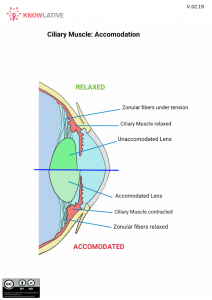The intrinsic muscles of the eye control two important functions:
- the size of the pupil: iris muscles (Iris Sphincter Muscle and Iris Dilator Muscle)
- the shape of the lens: Ciliary Muscle
Size of the pupil
Circular and radial muscles of the iris, named Iris Sphincter Muscle and Iris Dilator Muscle respectively, control how much light enters the eye.
- Outer iris smooth muscle, the Iris Dilator Muscle muscle, expresses alpha-1 adrenergic receptors, cause mydriasis when they contract, and are controlled by sympathetic fibers.
- The inner Iris Sphincter Muscle muscle is innervated by the parasympathetic division, express Acetylcholine muscarinic M3 receptors, and cause miosis when they contract.
Effect of light on the pupil:
- Parasympathetic activation by bright light causes constriction (Miosis)
- Sympathetic activation in response to dim light causes dilation (Mydriasis)
- An increase of light in one retina results in constriction of its pupil (direct light response); it also causes identical constriction in the other eye (consensual light response)
- This response not only regulates the total amount of light that enters the eye, but affects the quality of the retinal image (as in photography the size of the diaphragm regulates the depth of field)
Shape of the lens
The function of the lens is to focus an image on the retina. Depending on whether light rays are coming from an object seen up close (more bending of light required) or far away (less bending required), the lens changes shape to allow for this clear focus. The lens of the eye is an elastic biconvex structure made of crystalline protein.
The lens in a more spherical shape (more convex) will cause more bending of light and the lens in a more flattened state (less convex) will cause less bending of light.
The Ciliary Muscle of the eye control the shape of the lens-relaxation of the ciliary muscles will cause more tension in the suspensory ligaments to cause the lens to be more flat. Contraction of the ciliary muscles will release the tension on suspensory ligaments allowing the lens to return to its resting spherical shape.
Ciliary muscles are innervated by both parasympathetic and sympathetic fibers. Activation of beta 2 receptors expressed on ciliary muscles cause relaxation for far vision, while muscarinic receptors mediate contraction for near vision.

